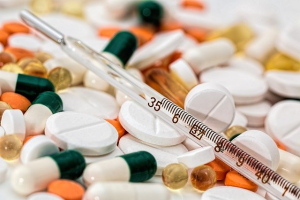The Danish researchers Niels Hadrup and Gitte Ravn-Haren have published a comprehensive study of the absorption, distribution, metabolism, and excretion of selenium obtained from food and from nutritional supplements [Hadrup 2021].

Here we summarize their findings with respect to selenium in selenium-enriched yeast supplements. We do this for two reasons:
- Selenium-enriched yeast supplements contain more than 20 different species of selenium in addition to the species selenomethionine. It may be that some of the selenium species other than selenomethionine – for example, the selenocysteine-se-methylselenocysteine compound – account for selenium’s protective effect against cancer [Larsen 2004].
- Selenium-enriched yeast supplements have been shown to reduce bio-markers of oxidative stress whereas pure selenomethionine supplements have not [Richie 2014].
Absorption of selenium from selenium-enriched yeast preparations
In a 2008 paper, researchers reported having given healthy elderly individuals 100, 200 or 300 mcg selenium in a selenium-enriched preparation daily for a period of 5 years. The supplementation resulted in mean plasma levels of 165, 221, and 260 mcg/L, respectively. In the control group, given a placebo for 5 years, the plasma selenium concentration was 92 mcg/L [Ravn-Haren 2008].
Hadrup and Ravn-Haren [2021] list comparative studies that indicate a higher bioavailability of selenium from selenium-enriched yeast than from inorganic sources of selenium such as selenite and selenate, which are, themselves, also well absorbed.
Distribution of selenium
Selenium from food and from nutritional supplements is distributed to all tissues and organs as selenocysteine in the 25 known selenoproteins or as selenomethionine in the general protein pool.
Hadrup and Ravn-Haren [2021] have compiled the data from many selenium studies and have concluded that the normal mean level is 139 mcg/L in blood and 23 mcg/L in urine.
The concentration of selenium in breast milk is 41 mcg/L, which is considerably lower than in the mother’s blood. Researchers assume, therefore, that the distribution of selenium to the breast milk is regulated.
They report that normal amounts of selenium in various tissues and organs in their figure 4. They speculate that selenium’s being found in similar amounts in different tissues could mean that selenium is a building block of proteins that are present in all tissues.
Metabolism of selenium
Hadrup and Ravn-Haren [2021] state that selenium from both organic and inorganic sources is built into the protein pool (selenium from organic sources) or metabolized to selenide (selenium from both organic and inorganic sources). The selenide is further metabolized into selenocysteine, which is then incorporated into selenoproteins, or the selenide is metabolized into excretory metabolites following methylation.
For an extensive review of the metabolism of selenium, please see the 2014 paper by Roman et al. Hadrup and Ravn-Haren present an overview of the metabolites of selenium in their figure 5.
Excretion of selenium
Alfthan et al. [1991] investigated selenium-rich yeast supplementation with a dosage of 200 mcg/day for 16 weeks. They found the half-life of the selenium in serum to be roughly 4 weeks. The serum selenium level continued to drop over the following 6 weeks after the final week, week 16, of supplementation.
In the Alfthan study, Finnish men who had taken 200 mcg/day of selenium from selenium-rich yeast preparations had increased urinary excretion (approximately160 mcg/day as compared to the control value of approximately 80 μg/day.
Hadrup and Ravn-Haren [2021] do not report data for the urinary and fecal elimination of selenium from selenium-yeast sources. They do report on a study in which an approximately similar percentage of selenium was excreted in the urine and the feces over the first two weeks after the ingestion of selenomethionine. In another study, the percentage of selenium excreted in the feces was considerably greater than the percentage excreted in the urine.
Summary of Selenium Pharmacokinetics
Based on the data from scientific studies, including comparative studies, Hadrup and Ravn-Haren concluded that organic selenium is more bio-available than inorganic selenium.
Sources
Alfthan G., Aro A., Arvilommi H., Huttunen J.K. Selenium metabolism and platelet glutathione peroxidase activity in healthy Finnish men: Effects of selenium yeast, selenite, and selenate. Am. J. Clin. Nutr. 1991;53:120–125.
Bügel S, Larsen EH, Sloth JJ, et al. Absorption, excretion, and retention of selenium from a high selenium yeast in men with a high intake of selenium. Food Nutr Res. 2008;52:10.3402/fnr.v52i0.1642.
Hadrup N, Ravn-Haren G. Absorption, distribution, metabolism and excretion (ADME) of oral selenium from organic and inorganic sources: A review. J Trace Elem Med Biol. 2021 Sep;67:126801.
Larsen EH, Moesgaard S, Paulin H, Reid M. Speciation and bioavailability of selenium in yeast-based intervention agents used in cancer chemoprevention studies. J AOAC Int. 2004 Jan-Feb;87(1):225-32.
Ravn-Haren G, Krath BN, Overvad K, Cold S, Moesgaard S, Larsen EH, Dragsted LO. Effect of long-term selenium yeast intervention on activity and gene expression of antioxidant and xenobiotic metabolising enzymes in healthy elderly volunteers from the Danish Prevention of Cancer by Intervention by Selenium (PRECISE) pilot study. Br J Nutr. 2008 Jun;99(6):1190-8.
Richie JP Jr, Das A, Calcagnotto AM, Sinha R, Neidig W, Liao J, Lengerich EJ, Berg A, Hartman TJ, Ciccarella A, Baker A, Kaag MG, Goodin S, DiPaola RS, El-Bayoumy K. Comparative effects of two different forms of selenium on oxidative stress biomarkers in healthy men: a randomized clinical trial. Cancer Prev Res (Phila). 2014 Aug;7(8):796-804.
Roman M, Jitaru P, Barbante C. Selenium biochemistry and its role for human health. Metallomics. 2014 Jan;6(1):25-54.
The information presented in this review article is not intended as medical advice and should not be used as such.
30 July 2021
